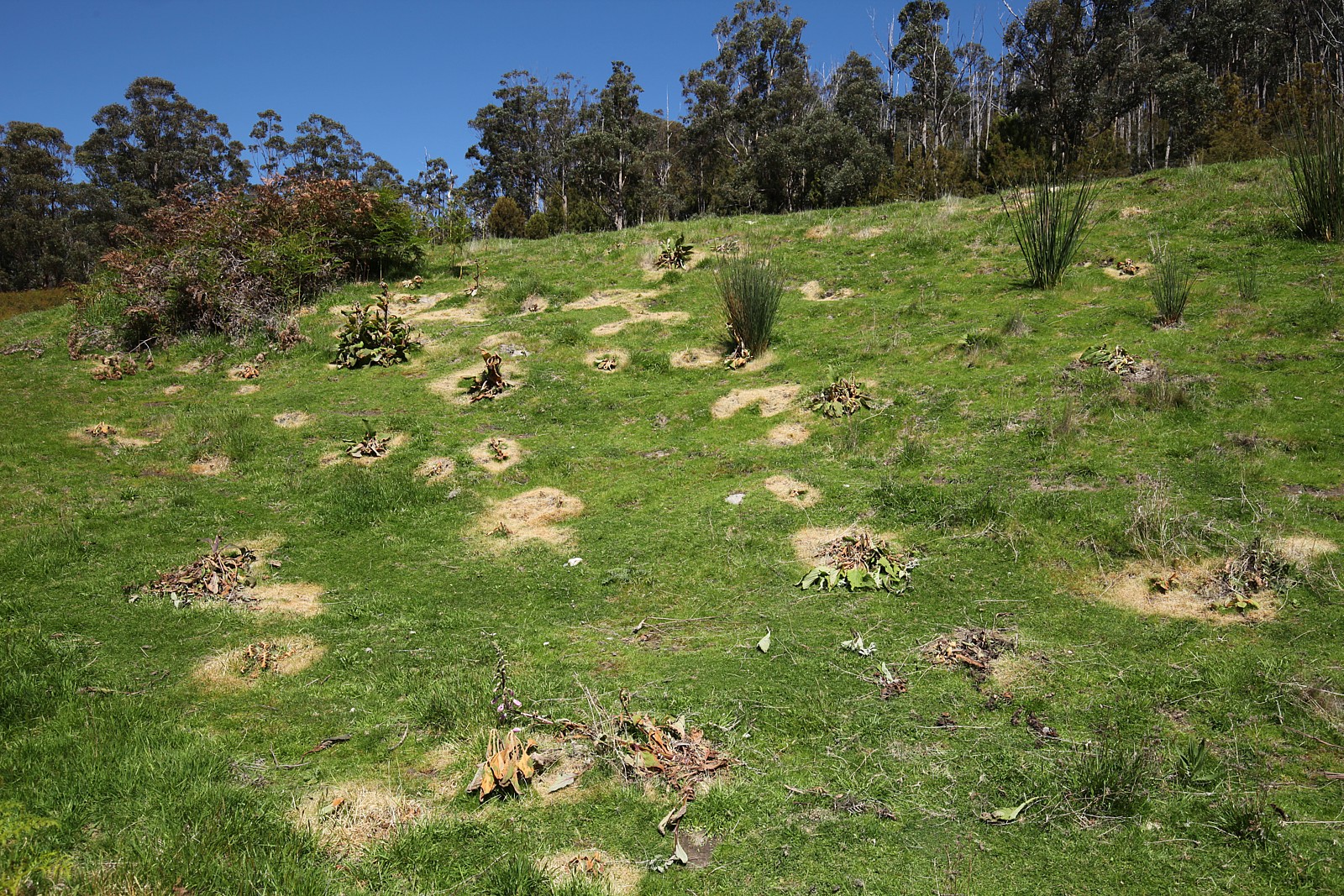effective spraying tips
- Spray early. Young plants are easy to kill. You use less chemical and put in less effort for a better result. It is a good idea to spray young growth in autumn, and follow up in early spring. You will find that, all things considered, this is more effective and much less work than trying to do one huge spray in the late spring or early summer. Safer too - you get to do all your spraying before the Tiger Snake season starts. The younger the plant, the easier and cheaper it is to kill.
- Spray in good weather: not too windy and not too calm, no rain expected that day, and not hot or cold. If you can't get nearly all the spray on the plant, it's too windy. Come back another day.
- Never spray in a dead calm. This is the cause of vapour drift damage and you can wind up killing all sorts of unexpected and valuable plants. Vapour drift damage to valuable plants is the single most common reason commercial spray contractors get sued. It is just as much a risk for small-scale spraying. As the spray dries, it gives off vapour (sometimes you can see this on a warm spring day). This vapour is very toxic to most plants. If there is a gentle breeze, it is dispersed and doesn't settle in any one place. That's fine. In still air, however, it can and does lift, drift over a few yards or a few hundred yards, and drop - killing next-door's roses, or a rare and precious native shrub. If you do an agricultural chemical user's course, you'll get this drilled into you over and over - because even qualified, experienced people screw it up. Make it a hard rule: if there is no breeze, do not spray.
- Use the recommended strength. Do not exceed the recommendation on the product label. (Measure, don't guess.) If the recommended strength isn't working, you are doing it wrong. Spraying under-strength wastes time and chemical, and breeds herbicide resistant plants. Spraying over-strength wastes money, puts unnecessary herbicide into the environment, and risks harming valuable plants. Use the right amount: no more, no less.
- Spray to the drip. Try to cover the entire plant (both sides of leaves is ideal, but whatever you can sensibly get at) and apply enough spray for it to just barely start dripping off the leaves.
- Don't spray close to water or watercourses. Hand-pull along the creeksides.
- Use a suitable selective herbicide. In general, avoid broad-spectrum herbicides like glyphosate ("Roundup") which kill plants indiscriminately. Your goal is to target the foxglove and encourage other plants which can compete with it: broadleaf-specific herbicides don't harm grasses. See the herbicide choice page.
- Don't demand instant results. It simply does not matter whether you get a kill in a few days or a few weeks or a few months. There are many variables: temperature, age of plant, recent rainfall, type of herbicide, time of year, dose rate, probably the colour of your socks. If you are getting very fast results, you might be using too much chemical. Check the label.
- Be aware of herbicide resistance. If you spray with the same chemical time after time, and you don't get a 100% kill (you won't - there are always a few escapees), you are effectively breeding chemical-resistant foxgloves. Only the ones that happen to be least harmed by (for example) MCPA will breed, and after a few seasons you have created a herbicide-resistant variety. To avoid this, switch chemicals every so often. If you have used MCPA for two or three years, switch to metsulfuron-methyl, or Slasher or whatever else you have that is suitable. Also, follow up on foot after a spray and deal with the survivors so that they can't breed. (Hand-pull or spot spray. If you are getting more than just a few, review your spray methods.)
- Don't be a skinflint, use a penetrant (except where the herbicide is self-wetting - check the label). "Pulse" is a well-known product but there are many others. Yes, you can spray without a penetrant, but you will use more chemical and get a poorer kill ratio. Yes, you can substitute with dishwashing liquid, but that is only doing half the job. A made-for-purpose wetting agent-penetrant (Pulse or similar) (a) spreads the spray out on the leaf evenly so that the entire surface is covered and you are not wasting chemical making liquid balls that don't stick properly to the leaf, and (b) helps the active chemical penetrate the tough outer leaf layer and get into the plant where it can do the business. Yes, penetrants are expensive. But you only need a very small amount (a teaspoon or two per backpack tank - read the label for specifics) and what you spend on Pulse you more than save on (i) not having to use extra herbicide, and (ii) getting a good kill first time and not having to respray. Don't look for excuses, just do it.
- Use a spray dye. It really is much easier and probably saves you money by helping avoid double coverage.
- There are many types of sprayers. Professional contracters use high-pressure petrol-driven sprayers mounted on the back of a ute and a 1000 litre tank. For most small landholders, a simple backpack sprayer is the most versatile: big enough to do pretty large areas if you stick at it, but handy enough to take into awkward spaces. Buy a decent one. Cheap, poor quality sprayers are nothing but trouble; good ones just work.
